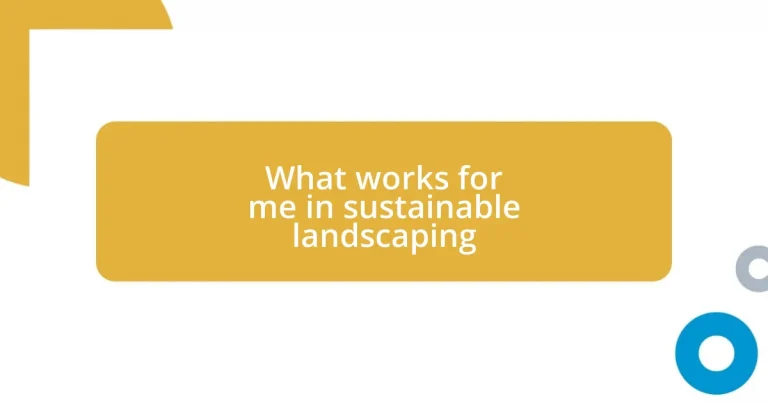Key takeaways:
- Sustainable landscaping practices enhance the ecosystem and can lead to biodiversity, water conservation, and healthier soil.
- Utilizing native plants provides low-maintenance options that require less water, attract wildlife, and support local ecosystems.
- Community involvement in landscaping fosters connections and can enhance projects, making them more impactful and enjoyable for all participants.
- Implementing techniques like drip irrigation, composting, and mulching can significantly conserve resources and improve garden health.

Understanding sustainable landscaping practices
Sustainable landscaping practices center around creating environments that benefit the ecosystem while still meeting our needs. I remember when I first transitioned my yard to a more sustainable design; it felt daunting but rewarding as I watched local wildlife flourish. It’s amazing how small changes can lead to significant impacts, like utilizing native plants that not only require less water but also provide habitats for birds and insects.
One fundamental aspect of these practices is the mindful use of resources. For instance, I started collecting rainwater to irrigate my garden, reducing my water bill and my reliance on municipal sources. Have you ever considered how much water can go to waste during heavy rains? By directing that water to my landscape, I’ve seen my plants thrive while making a positive impact!
Another essential practice is composting, which I’ve found invaluable in promoting healthy soil. Initially, I hesitated, thinking it would be too messy or complex, but once I got started, it became second nature. Watching my kitchen scraps naturally decompose into nutrient-rich soil was a revelation—it really highlighted the cycle of life in my backyard. Are you ready to turn your own food waste into a resource? Sustainable landscaping is not just about aesthetics; it’s about working in harmony with nature and feeling connected to something larger.

Benefits of sustainable landscaping
Sustainable landscaping offers benefits that extend far beyond just a beautiful yard. One standout advantage I’ve observed is the immense boost in biodiversity. When I replaced traditional flower beds with pollinator gardens, it was like flipping a switch. Suddenly, I had butterflies and bees dancing around my space, bringing a vibrant energy that felt so alive. The joy that comes from observing these interactions is truly heartwarming; it’s a reminder of how interconnected we are with nature.
Here are a few key benefits I’ve experienced firsthand:
- Reduced Water Usage: Incorporating drought-resistant plants has substantially lowered my watering needs.
- Enhanced Soil Health: Utilizing organic mulches and compost has improved the soil structure, giving my plants a robust foundation to grow.
- Pest Control: Companion planting has naturally deterred pests, reducing the need for chemical interventions.
- Carbon Sequestration: My trees and shrubs play a role in absorbing CO2, contributing to cleaner air around my home.
- Aesthetic Appeal: Natural landscapes provide a serene environment that is both calming and visually pleasing, uplifting my spirits daily.
Engaging more with nature through sustainable methods has shifted my perspective in profound ways. It’s an investment not just in my home but in the world we all share.

Choosing native plants for gardens
Choosing native plants for gardens is a wonderful way to connect with the local environment and nurture biodiversity. I remember the first time I visited a garden filled with native species; it felt so alive, buzzing with pollinators and vibrant with color. Choosing plants that are indigenous to my area helped me create a low-maintenance landscape that thrives without excessive watering or fertilization. It’s deeply satisfying to see how native plants can seamlessly blend into the local ecosystem.
When I was starting, I was thrilled to discover the variety of native plants available, many of which weren’t familiar to me. For example, incorporating local wildflowers like black-eyed Susans and coneflowers not only introduced stunning visuals but also attracted hummingbirds and butterflies. There’s something magical about watching them flit around my garden—it brings a sense of joy and wonder that elevates my outdoor experience. Have you visited a garden filled with native plants? There’s a unique beauty in their organic, wild forms.
To further emphasize the significance of native plants, I created a comparison table highlighting some key aspects:
| Native Plants | Non-Native Plants |
|---|---|
| Adapted to local climate | May require extra water and care |
| Support local wildlife | Often do not provide habitats for native species |
| Minimal pest issues | Higher likelihood of pest problems |
| Require less maintenance | May need regular pruning and fertilization |

Implementing water conservation techniques
Implementing water conservation techniques in my landscaping has been a game-changer, not only for the environment but for my peace of mind. One of the simplest methods I adopted was installing drip irrigation. Unlike traditional sprinklers that waste water through evaporation and runoff, drip systems deliver moisture straight to the roots. I remember the first time I saw my garden thrive with this approach; it felt like a victory for both my plants and my water bill.
Additionally, I started using rain barrels to collect runoff from my roof. Catching that free water source felt incredibly satisfying, especially during dry spells. The feeling of being proactive and resourceful really made a difference in my perspective on gardening. It’s hard not to smile when I fill up my watering can with rainwater, knowing I’m doing my part to conserve a precious resource. Have you ever thought about how much you could save by harnessing rainwater? It’s a small change that can have a big impact.
Lastly, mulching has become one of my favorite techniques for conserving moisture in the soil. After I put down a thick layer of organic mulch, I noticed how much less frequently I needed to water my plants. It not only retains moisture but also suppresses weeds, which is a double win in my book! The earthy smell of mulch and the sight of healthy plants thriving in it make my garden feel like a sanctuary. Have you tried mulching yet? Trust me; it enhances both the beauty of your garden and your commitment to sustainability.

Designing for biodiversity in landscapes
Creating landscapes that foster biodiversity has been a transformative experience for me. One of the most effective strategies I’ve employed is layering plants of varying heights. This not only enhances visual interest but also provides habitats for different wildlife species. The thrill of stumbling upon a hidden nest or witnessing small creatures navigate the undergrowth brings a sense of delight that enriches my gardening journey. Have you ever noticed how different levels in a garden can create a mini-ecosystem?
Another approach I’ve found especially rewarding is incorporating diverse plant species into my garden beds. By mixing flowers, shrubs, and trees, I invite a range of pollinators, like bees and butterflies, to take part in the landscape. I remember the first time I saw a cluster of bees eagerly buzzing around an array of flowers—what a sight! It made me realize the interconnectedness of life in my yard. This diversity not only attracts wildlife but also helps in pest control naturally. When you bolster your landscape with various plants, you essentially create a balanced environment that can thrive on its own.
I’ve also discovered the joy of adding native shrubs and trees that produce berries or seeds. Watching birds flock to my garden during the fall to snack on these treats fills me with joyous anticipation. The vibrant colors of the berries and the lively chatter of the birds create a lively atmosphere that enhances my outdoor experience. It’s a reminder that even the smallest changes in garden design can lead to vibrant ecosystems. What’s your favorite way of inviting wildlife into your space?

Maintenance tips for sustainable gardens
Maintaining a sustainable garden has taught me the importance of hands-on care while being kind to the environment. Regularly checking for pests and diseases is crucial because ignoring them can lead to bigger problems down the line. I remember the first time I caught aphids early on my tomato plants; treating them promptly saved not just the crop, but also my growing enthusiasm for gardening. Have you ever felt that satisfaction of catching an issue before it spirals out of control?
Encouraging beneficial insects has been another successful strategy in my maintenance routine. Instead of reaching for chemical sprays, I’ve learned to welcome ladybugs and lacewings into my garden. A simple planting of dill and yarrow attracts these helpful allies, turning my garden into a cooperative ecosystem. Watching them do their work is a delightful reminder of nature’s balance. How rewarding is it to see a problem resolved through harmony rather than conflict?
Of course, seasonal adjustments are vital too. I make it a habit to cut back perennials in the fall, creating a tidy space for new growth while providing shelter for overwintering creatures. This practice not only keeps my garden looking neat, but it also means I’m contributing to a habitat that supports life through the colder months. Seeing the first sprigs emerge in spring feels all the more special when I remember I played a part in their preparation. Have you felt that magical connection to your plants as they wake up each season? It’s these little yet significant actions that fuel my sustainable gardening journey.

Community involvement in landscaping efforts
Community involvement in landscaping efforts can truly elevate a project from good to remarkable. I recall when my neighborhood organized a tree-planting day. The sense of camaraderie was palpable as we dug into the earth together, sharing laughter and stories while making our community greener. Have you ever felt that rush of pride when working side by side with others to improve a shared space? It transcends just the physical act; it fosters connections among participants.
Collaboration with local schools has also been a wonderful experience for me. When we partnered to create a sensory garden for students with special needs, it brought a sense of purpose and joy to all involved. The joy on the children’s faces as they touched the varied textures of plants was unforgettable. Isn’t it amazing how community landscaping can touch lives on such a personal level? Engaging everyone in the design and maintenance process creates not just beauty but also a sense of belonging.
I’ve seen that including local businesses in landscaping projects can enhance both aesthetics and community spirit. In one instance, a local bakery donated pastries for one of our gardening workshops, turning a simple planting session into a festive event. This collaboration sparked interest and turnout that we had never anticipated. Have you ever noticed how a shared meal can strengthen community ties? It’s proof that sustainable landscaping isn’t just about the plants; it’s about nourishing relationships alongside nature.












